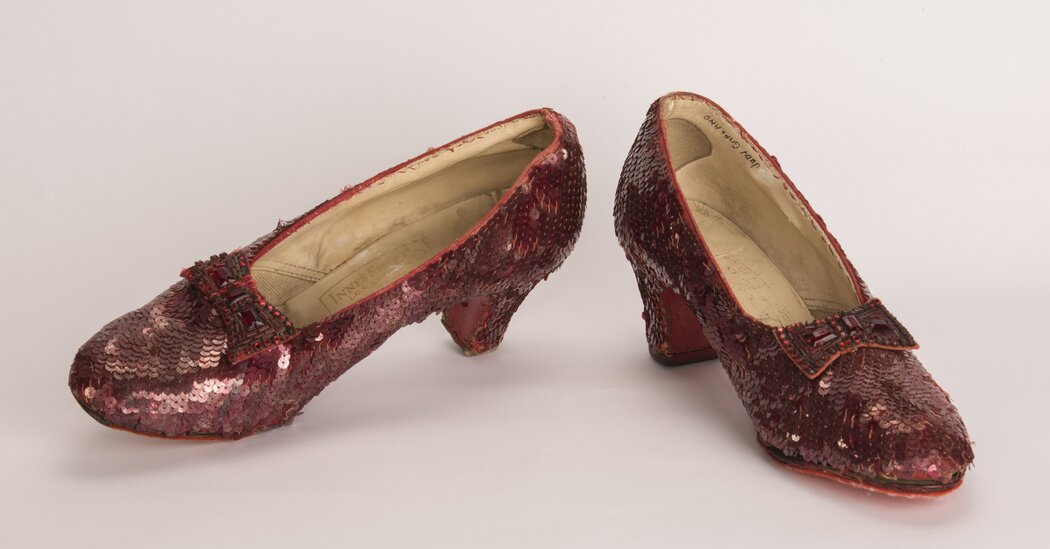Nearly two decades after he broke into the Judy Garland Museum in Grand Rapids, Minn., and stole a pair of Dorothy’s ruby slippers used in “The Wizard of Oz,” the man who committed the theft has revealed why: He believed the slippers were adorned with real rubies.
Terry Martin, now 76, had never seen “The Wizard of Oz” and had “no idea” that the shoes were among the most recognizable cultural objects in American film when he stole them on the evening of Aug. 27, 2005, his lawyer, Dane DeKrey, wrote in court papers this month.
Instead, Mr. Martin believed that the slippers must have been made with “real rubies” to justify their $1 million insured value, prosecutors said. He believed he would be able to peel off the gems and sell them on the black market — a plan that backfired when a man who traded in stolen jewels informed him that the gems were made of glass.
On Monday, Mr. Martin was spared prison and instead sentenced in U.S. District Court in Duluth, Minn., to one year of supervised release for stealing the slippers after he pleaded guilty in October to one count of theft of a major artwork. He was also ordered to pay $23,500 in restitution to the museum.
Federal prosecutors and Mr. DeKrey had agreed that Mr. Martin should not be incarcerated because he has chronic obstructive pulmonary disease, requires oxygen and is in hospice care. He is not expected to live beyond the next six months, prosecutors said.
The motive for the theft was revealed in sentencing memos filed by Mr. DeKrey and by prosecutors this month that explained more about Mr. Martin’s life story and his involvement in the heist.
Mr. Martin had dealt in stolen jewels and had spent time in prison for burglary, his lawyer said. But he had been out of prison for 10 years at the time of the theft in 2005 and was living quietly in Grand Rapids, a small city 80 miles northwest of Duluth, when an “old mob associate” contacted him about “a job,” his lawyer wrote.
Mr. Martin was initially reluctant to get involved, Mr. DeKrey wrote. But “old Terry” beat out “new Terry,” and he gave in to the temptation for “one last score,” his lawyer said.
“His intent was singular: He believed the gemstones affixed to the slippers were real rubies, and so he hoped to steal the slippers, remove the rubies, and sell them on the black market through a jewelry-fence,” a person who buys and sells stolen jewels, Mr. DeKrey wrote.
Mr. Martin used a hammer to smash two window panes in a door of the Garland Museum and broke open a plexiglass case holding the shoes, leaving behind a single red sequin and no fingerprints, court documents said.
But less than two days later, when the unnamed person who traded in stolen jewels told Mr. Martin that the gems were worthless replicas, “Terry angrily decided to simply cut his losses and move on,” Mr. DeKrey wrote. “He gave the slippers to the associate who had recruited him for the job and told the man that he never wanted to see them again.”
Investigators had no credible leads in the search for the slippers until an unnamed person contacted the Grand Rapids Police Department, promising to help return the shoes in exchange for a $200,000 reward, prosecutors said. Ultimately, people connected to the theft sought to extort even more money from the insurance company that owned the shoes, saying if their demands weren’t met, they would hold on to the slippers for 10 years and “explore other options,” prosecutors said.
F.B.I. agents set up a sting operation that recovered the slippers in Minneapolis on July 10, 2018. Federal officials said they had a market value of $3.5 million and were one of four known surviving pairs from “The Wizard of Oz.”
Prosecutors have not identified or charged anyone else in connection with the theft, including the mob associate who Mr. Martin claimed solicited the heist or the people accused of trying to extort the insurance company. Mr. Martin has refused to cooperate with investigators in any way other than admitting his own conduct, Mr. DeKrey wrote.
But Mr. DeKrey wrote that people who had tried to capitalize on the theft were not “some cast of low-rent criminals trying to get paid. It was people with real juice, whose associations included organized crime and the federal government.”
If Mr. Martin “wanted a piece of this action, he easily could have reached out to the man who recruited him for the job and demanded a taste,” Mr. DeKrey wrote. “He’s the one who stole the slippers, after all. But he didn’t.”
Instead, Mr. Martin went back to living quietly in Grand Rapids, Mr. DeKrey wrote. He reconnected with his children and began a new romance, he wrote.
“Terry Martin never meant to be a criminal celebrity,” Mr. DeKrey wrote. “He happened upon it when he broke two panes of glass in a museum and stole a pair of red sequined slippers. He deeply regrets this decision and is ready to accept his punishment. But he’s no monster. He’s a dying man ready to meet his maker.”



